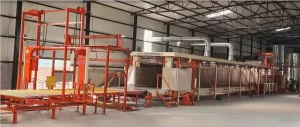In the realm of foam production, continuous polyurethane foam machines play a pivotal role in delivering high-quality, flexible polyurethane foam efficiently and reliably. As an essential investment for foam manufacturers, proper maintenance of these machines is paramount to ensuring longevity and optimal performance. Let’s delve into the best practices for maintaining your continuous foaming machine, with a focus on the CFM MAGNA model by A S Entterprises.

Understanding the Continuous Foaming Machine MAGNA
The Continuous Foaming Machine MAGNA, manufactured by ASE, is a powerhouse designed for the seamless production of flat top flexible PU foam. With its high capacity and user-friendly operation, the MAGNA is equipped to meet the demands of modern foam manufacturing processes. Key features include a three-conveyor system, large PLC touch panel for operation, recipe storage and recall, digital flow control, silicon-air mixer, and online density and colour change capabilities.
Importance of Regular Maintenance
Continuous foaming machines are complex systems composed of various components working in tandem to produce consistent foam output. Without proper maintenance, these machines are susceptible to wear and tear, leading to decreased efficiency, production downtime, and repairs, etc. By implementing a proactive maintenance regimen, foam manufacturers can mitigate potential issues and prolong the lifespan of their continuous polyurethane foam machines.
Best Practices for Continuous Foam Machine Maintenance
Here are some the best practices for maintaining your continuous foam machine:
- Routine Inspection and Cleaning: Schedule regular inspections of your MAGNA machine to identify any signs of wear, damage, or debris accumulation. Pay particular attention to critical components such as conveyor belts, mixing chambers, flow control valves, and sensors. Cleanliness is key to preventing clogs and ensuring smooth operation.
- Lubrication of Moving Parts: Keep moving parts of the continuous foaming machine well-lubricated to reduce friction and minimize wear. Apply lubricants as recommended by the manufacturer to conveyor chains, bearings, gears, and pneumatic components. Proper lubrication helps maintain optimal performance and extends the life of mechanical components.
- Calibration and Adjustment: Regularly inspect and adjust settings such as flow rates, pressure levels, and temperature controls to maintain consistency in foam quality and density. Utilize the digital flow control and PLC touch panel features of the MAGNA for precise adjustments and monitoring of production parameters.
- Sensor Calibration and Maintenance: Ensure that sensors responsible for monitoring foam density, colour, and flow rates are aligned accurately and functioning properly. Regularly inspect and clean sensors to prevent inaccuracies and maintain reliable performance during production runs.
- Documentation and Record-Keeping: Maintain detailed records of maintenance activities, including inspection dates, repairs, part replacements, and calibration adjustments. This documentation not only serves as a reference for future maintenance tasks but also provides valuable insights into the machine’s performance and longevity over time.
Conclusion
Continuous PU foam machines like the ‘MAGNA’ are invaluable assets in foam manufacturing, offering efficiency, reliability, and versatility. By adhering to best practices for maintenance, foam manufacturers can safeguard their investment and maximize the performance and longevity of their continuous polyurethane foam machines. With regular inspection, cleaning, lubrication, and training, one can ensure that the ‘MAGNA’ machine operates at peak efficiency, delivering high-quality foam products consistently.
